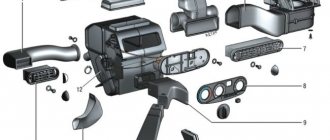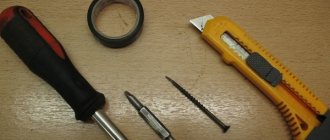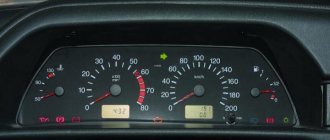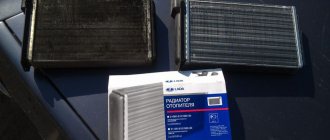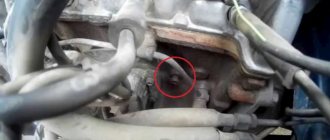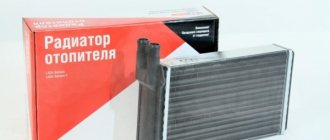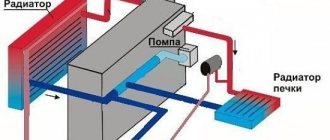string(10) “error stat”
With the onset of the first cold weather, every car owner pays special attention to the heating system of his car. This is especially true for domestically produced machines, in which malfunctions occur quite often. Often, owners of such cars are faced with the problem that the interior is poorly heated or does not warm up. Among the possible causes, the most common are the following:
- An air lock that has formed in the cooling system. In this case, high pressure is created in the radiator, which can lead to depressurization of the system;
- Heater motor malfunction;
- The stove faucet does not open completely. Quite often it happens that it turns sour and does not open;
- The heater radiator is clogged due to which warm air does not enter the car interior;
- Wear or corrosion damage to the structure.
If these problems are identified, for further operation of the heating system it is necessary to remove or replace the stove radiator. In some cases, it can be repaired, but before that, you need to find out the material of the radiator. Basically, they are made of copper or aluminum. Radiators made from copper are more expensive, but have a long service life, and in some cases they can be repaired. Repair of the stove radiator is carried out by soldering. Their cost varies between 1500-2000 rubles.
Due to their low price, aluminum products are more common, but less reliable. The price of aluminum radiators is approximately 700-1000 rubles. In any case, you first need to remove the heater radiator from the car, and then plan your next actions.
Inconvenient design solutions
VAZ-2114 and 2115 cars are quite modern and quite popular cars in the budget segment.
But in these cars, as in most new models, there is one not very pleasant feature.
By increasing the comfort of the interior and the design of the front panel, designers significantly complicate the maintenance of the heating system.
The heater radiator in these cars is hidden deep under the panel and is not so easy to get to.
But the heating radiator is a rather vulnerable element of the cooling system. And if the heating of the interior has deteriorated, in more than half of the cases the problems are related specifically to the heat exchanger.
And all this despite the fact that the element itself is practically not repairable and is often simply replaced.
Drain the ANTIFREEZE / ANTIFREEZE
We unscrew the bolt, but before doing this, do not forget to place a container underneath into which the liquid will be drained. It is worth unscrewing a little at a time, gradually draining the liquid, and when the bulk is drained, you can unscrew the cap of the expansion tank. But you shouldn’t do this right away, as the pressure will be strong and the liquid will spill with a 99% chance.
Main reasons for replacement
There are not many reasons why it may be necessary to replace the radiator of the interior heating system. One of them is the appearance of a leak.
Heat exchangers are made of non-ferrous metals - copper or aluminum.
Gradually, these metals oxidize due to exposure to liquid, which leads to the appearance of cracks through which coolant flows out.
The second reason for replacing the heater radiator is clogging of the tubes with contaminants. The coolant, circulating through the cooling system, washes away corrosion products, small particles, etc.
Moreover, the liquid cannot contain them and these polluting elements settle on surfaces, including the stove radiator.
As a result, the heating system first loses efficiency, and later (if it is heavily contaminated) it simply stops working.
In some cases, radiator blockages can be eliminated by flushing using chemicals.
But if the blockage of the tubes is severe, then the plugs can only be removed from the dirt mechanically. And this can only be done with the radiator removed.
Before you start disassembling, you should first make sure that the problems arose with the radiator.
So, a leak of this element is manifested by the appearance of traces of antifreeze on the floor in the cabin.
But the same result can also be caused by damage to the radiator pipes or loss of tightness at the point of their connection with the heat exchanger.
A decrease in heating efficiency can occur not only due to blockage of the radiator tubes, but also due to severe clogging of its honeycombs.
Dust, fluff, leaves, and insect remains get clogged between the cooling fins, making it difficult to transfer heat to the air.
But in this case, it is very easy to identify the problem - turn on the stove fan at full power and check the air flow from the deflectors.
If it is not strong, the radiator should be cleaned, which also cannot be done efficiently without removing the element.
The stove may also stop heating due to the radiator becoming airy, which often happens when replacing the coolant. Often the cause is a malfunction of the cooling system elements, especially the thermostat.
In general, before removing the heater radiator, you should make sure that it is the cause of poor interior heating that is hidden there. And for this you will have to check almost the entire cooling system.
How to solder an aluminum radiator tube: main types of fluxes and solders
| Soldering agent | Solder/flux composition | What kind of damage is it suitable for? |
| Iron rosin flux | P150A, P250A, P350A, POS-60, for flux – iron filings + rosin (proportions 1:2). | Minor damage to honeycombs, cracks on tubes, etc. |
| Smelter for aluminum | Plaven:
| Small and medium cracks, holes up to 5 mm. |
| Flux solder for aluminum | Castolin 192 FBK, Castolin 196, HTS 2000, Filalu 1192 NC. | Minor and medium damage to honeycombs and tubes, up to 5–10 mm. |
| Solder with gun oil |
| Small and medium damage up to 5 mm. |
| Soldering aluminum with copper |
|
|
| Aluminum solder and flux for aluminum | P150A, P250A, P350A + flux for aluminum F-64, LTI-120 or SF-OR/AL-19. | Minor and medium damage to tubes, honeycombs, up to 5–10 mm. |
| Thermite pencil | Thermite pencil for soldering and welding like "Extrapike". | Small and medium holes, up to 5 mm. |
| Epoxy adhesive |
| Small and medium damage, with reinforcement - and large (more than 10 mm). |
| Cold welding | ASTROhim ACE-9305, Abro Steel, Mannol 9928, Abro TM-185. | Minor and medium damage to honeycombs, tubes, up to 10–15 mm. |
Methods for replacing a radiator
There are two ways to remove the heater radiator on a VAZ-2113, 2114, 2115. The first involves completely removing the front panel
, which is necessary to access the heat exchanger.
Note that complete dismantling is a relative concept, since the panel itself is not removed from the car, but is only disconnected from the body, which allows it to be moved and thereby allow access to the radiator.
You will also have to move the torpedo itself.
Second method - without removing the panel
. But it is not suitable for everyone, since to provide access it is necessary to make cuts in some places so that it is possible to tilt the lower part of the panel in the area where the heat exchanger is located.
The disadvantage of the first method is that it is labor-intensive, since you will have to unscrew a lot of fasteners and disconnect the wiring, of which there is a lot that goes to the panel.
As for the second method, the panel itself will essentially be damaged, although it is cut in places hidden from view.
Also, after completing the replacement, you will have to think about how to reattach and secure the cut parts.
But since the stove radiator can leak at any time, ease of access to it is very important, so the second method is preferable.
Unscrew a few bolts
We unscrew the bolts on the passenger side, the first two bolts must be unscrewed with a screwdriver (they hold the dashboard itself directly), and the third bolt with an “8″ wrench or a socket head (this will be much more convenient. And the fourth is located on the driver’s side in the same place, as well as the third bolt. They hold, so to speak, BRAINS))).
After the bolts are unscrewed, the dashboard will have free play, which will allow you to move the dashboard and get to the radiator itself.
Selecting a replacement radiator
But before you begin the removal and replacement operation, you should first select a new heat exchanger.
You can buy a factory heater radiator, catalog number 2108-8101060. But analog products made by DAAZ, Luzar, Fenox, Weber, and Termal are also quite suitable.
As for the material, it is recommended to use copper heat exchangers, but they are much more expensive than aluminum ones. Although this is not an acquired taste, many people use aluminum products and are quite satisfied.
In general, the main thing is that the radiator is designed specifically for these cars.
The designers used the same front panel design on the VAZ-2113, 2114 and 2115 models, so the replacement algorithm is the same for them.
Next, we’ll look at how to remove the radiator of the interior heating system using the example of a VAZ-2114, and how this is done in different ways.
What heater regulators are installed on Lanos 1.5 and 1.6 and their purpose
On the central panel in the interior of the Lanos car there are regulators through which the heater is turned on, as well as setting and adjusting the operation. Below is a photo showing the controls.
- The regulator by which damper 4 in the diagram above is activated. Provides opening and closing of the channel for supplying air through or bypassing the radiator
- Turning on the fan and rotation speed of the blades
- Regulator through which air flow distribution is adjusted
- Rear window defroster button
- A slider that opens the air supply from outside or from the passenger compartment to the system
- Button for turning the air conditioner on and off - not present on all models, but only on TOP versions of Lanos
The regulators are connected to the dampers via steel cables. Each regulator is controlled regardless of whether the stove is on or not.
This is interesting!
The radiator is a heat exchanger in which coolant flows through the lamellas. The main malfunction of the device is that the integrity of the lamellas is compromised, and antifreeze leaks occur. In this case, you will need to replace the device with a new one.
Replace without removing the panel
But no matter what method is used, you will first have to drain the coolant from the system. Therefore, you will have to stock up on antifreeze in the required quantity in advance.
First, let's look at the replacement method without removing the panel. As already mentioned, this will require making cuts in some places.
To complete the work you will need:
- Set of screwdrivers of different lengths;
- Hacksaw blade for metal;
- Flat container for draining residual coolant from the radiator;
- Rags.
Having prepared everything and drained the coolant from the cooling system, you can begin work:
- We remove the storage box (glove compartment) from the panel, for which it is necessary to unscrew 6 screws securing it;
- Remove the side trims on the center console;
- Use a metal blade to make the necessary cuts: The first cut is vertical
, we do it on the inner wall of the panel near the center console (behind the metal strip of the glove compartment). Moreover, here you will have to make two cuts.
The second cut is horizontal
, runs in the upper part along the rear wall of the opening under the glove compartment.The third is also vertical
, but not end-to-end. It is done on the right on the rear wall of the lower storage shelf of the panel; - After all the cuts, part of the panel together with the wall can be bent down, which will provide access to the radiator. We bend this part and fix it;
- Unscrew the near bracket for fastening the heating system flap control cable and move the cable to the side;
- Loosen the clamps of the coolant supply pipes to the radiator. In this case, you should place a prepared container under the connection points, since liquid will flow out of the heat exchanger. Remove the pipes;
- We unscrew the three screws securing the radiator, remove it and immediately inspect it.
Afterwards we replace the heat exchanger, fix it in the seat, connect the pipes to it and clamp it with clamps. To make the pipes fit easily, lubricate them with soap.
At this stage of work, you should fill the cooling system with liquid and run it to remove air pockets.
Next, it remains to make sure that the connections between the pipes and the radiator are not leaking, and that the damper and faucet are connected without errors.
After this, all that remains is to return the cut part of the panel to its place and fix it. To do this, you can use screws and plates.
The main thing is to fix it in several places so that in the future the cut off part does not rattle when moving. Use sealant or silicone.
This method is convenient because if you replace the radiator again (which is quite possible), all the work will be very simple - you just need to remove the storage box and unscrew a few screws.
In addition, all cuts are made in such places that after assembling the panel and installing the glove compartment they will not be noticeable.
Unscrew the pipes
After draining the liquid from the system, you need to unscrew the pipes leading to the radiator. Be careful, there may be liquid left in the radiator.
Then we unscrew the three screws that hold the radiator itself and pull it out.
Don't forget to clean the inside of the stove from leaves and other debris. Then we install a new radiator and reassemble in the reverse order.
This method helped me save a lot of time and did not require complete disassembly of the dashboard, which is good news.
